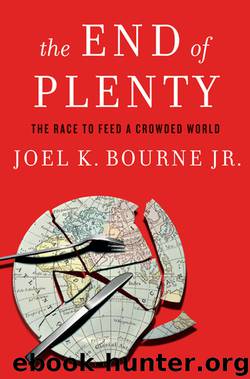The End of Plenty by Joel K. Bourne

Author:Joel K. Bourne
Language: eng
Format: epub
Publisher: W. W. Norton & Company
Flood-resistant rice—a product of modern genetic technology—grows in a greenhouse at UC Davis.
CHAPTER 11
Magic Seeds
Feeding Shareholders or the World?
In my dream I see green, vigorous, high-yielding fields of wheat, rice, maize, sorghums, and millets, which are obtaining, free of expense, 100 kilograms of nitrogen per hectare from nodule-forming, nitrogen-fixing bacteria.—Norman Borlaug, 1970
In 2002, several countries across southern Africa found themselves on the verge of famine. Torrential rains the previous year had flooded much of the critical maize crop, and the following season erratic showers dribbled off into the worst drought to bake the region in a decade. Just as during the Bengal famine of 1943, poor government policies exacerbated the natural disaster. Zimbabwe’s President Robert Mugabe ramped up his campaign to seize large commercial farms owned by white Zimbabweans, crippling production. At the same time, the government of perpetually malnourished Malawi, in an effort to pay down its national debt, sold all 165,000 tons of its grain reserves, leaving the country with nothing for emergencies. By the spring of 2002, more than 14 million people in Zambia, Zimbabwe, Malawi, Mozambique, Swaziland, and Lesotho were facing starvation. Many resorted to eating leaves and roots, watching helplessly as their children’s bellies swelled with hunger.
The World Food Programme of the United Nations leapt into action, requesting a million tons of emergency food aid from donor nations—more than half of which came from the United States. Shiploads of corn, soy, and cornmeal were promptly dispatched to southern Africa. By July the food aid had begun to flow. Everything went smoothly, with distribution centers passing out donated grain to the starving.
Sending food to hungry people sounds simple, but the politics of food aid is anything but. In the midst of the crisis, the leaders of the starving countries discovered that some of the corn donated by the United States came from genetically modified varieties. A year earlier the African Union had approved a model law on biosafety that allowed African nations to severely restrict the flow of GM crops into their countries. To opponents of the controversial technology, the United States appeared to be using the crisis to slip GMOs into Africa. The proverbial “frankenfood” hit the fan.
Swaziland and Lesotho, countries dependent on US trade, took the food aid without much objection. But Malawi, Mozambique, Zambia, and Zimbabwe balked, citing concern for their native biodiversity and their citizens’ health, especially HIV sufferers, even though thousands had eaten the grain without ill effects. The African leaders were also afraid that farmers would save the free seed and plant it, jeopardizing critical agricultural trade with Europe, where GMOs must be segregated and labeled—a prohibitively expensive task for poor nations with millions of small farmers. As a result, these countries halted distribution of free food in the midst of the famine, and the red-white-and-blue bags of US grain piled up in guarded warehouses.
Malawi, Mozambique, and Zimbabwe eventually accepted the proffered corn on the condition that it be milled first to prevent it from being planted. But Zambia held up the US grain until a panel of the country’s top scientists deemed it safe.
Download
This site does not store any files on its server. We only index and link to content provided by other sites. Please contact the content providers to delete copyright contents if any and email us, we'll remove relevant links or contents immediately.
| Automotive | Engineering |
| Transportation |
Whiskies Galore by Ian Buxton(41523)
Introduction to Aircraft Design (Cambridge Aerospace Series) by John P. Fielding(32881)
Small Unmanned Fixed-wing Aircraft Design by Andrew J. Keane Andras Sobester James P. Scanlan & András Sóbester & James P. Scanlan(32566)
Craft Beer for the Homebrewer by Michael Agnew(17926)
Turbulence by E. J. Noyes(7689)
The Complete Stick Figure Physics Tutorials by Allen Sarah(7134)
Kaplan MCAT General Chemistry Review by Kaplan(6582)
The Thirst by Nesbo Jo(6431)
Bad Blood by John Carreyrou(6268)
Modelling of Convective Heat and Mass Transfer in Rotating Flows by Igor V. Shevchuk(6218)
Learning SQL by Alan Beaulieu(6023)
Weapons of Math Destruction by Cathy O'Neil(5818)
Man-made Catastrophes and Risk Information Concealment by Dmitry Chernov & Didier Sornette(5638)
Digital Minimalism by Cal Newport;(5376)
Life 3.0: Being Human in the Age of Artificial Intelligence by Tegmark Max(5180)
iGen by Jean M. Twenge(5149)
Secrets of Antigravity Propulsion: Tesla, UFOs, and Classified Aerospace Technology by Ph.D. Paul A. Laviolette(4972)
Design of Trajectory Optimization Approach for Space Maneuver Vehicle Skip Entry Problems by Runqi Chai & Al Savvaris & Antonios Tsourdos & Senchun Chai(4837)
Electronic Devices & Circuits by Jacob Millman & Christos C. Halkias(4739)
